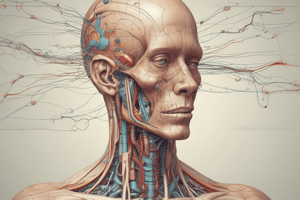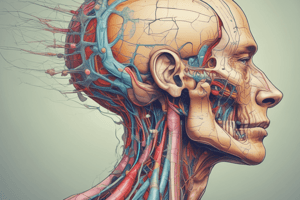Podcast
Questions and Answers
Which cranial nerve is responsible for carrying smell information?
Which cranial nerve is responsible for carrying smell information?
- Trigeminal nerve (V)
- Olfactory nerve (I) (correct)
- Auditory nerve (VIII)
- Optic nerve (II)
Which bone forms the back of the cranium?
Which bone forms the back of the cranium?
- Temporal bone
- Occipital bone (correct)
- Frontal bone
- Parietal bone
Which facial bone forms the lower part of the nasal septum?
Which facial bone forms the lower part of the nasal septum?
- Zygoma bone
- Vomer bone (correct)
- Maxilla bone
- Lacrimal bone
Which muscle flexes the neck and rotates the head?
Which muscle flexes the neck and rotates the head?
How many pairs of cranial nerves emerge from the brain?
How many pairs of cranial nerves emerge from the brain?
What are the soft spots on the skull that fuse after birth called?
What are the soft spots on the skull that fuse after birth called?
Which cranial nerve is responsible for controlling swallowing?
Which cranial nerve is responsible for controlling swallowing?
Which bone forms the roof of the orbit?
Which bone forms the roof of the orbit?
What is the primary function of the trigeminal nerve?
What is the primary function of the trigeminal nerve?
Which bone forms the posterior wall of the orbit?
Which bone forms the posterior wall of the orbit?
What is the name of the suture between the frontal and parietal bones?
What is the name of the suture between the frontal and parietal bones?
Which cranial nerve is responsible for controlling the muscles of facial expression?
Which cranial nerve is responsible for controlling the muscles of facial expression?
Which bone forms the upper part of the nasal septum?
Which bone forms the upper part of the nasal septum?
Which muscle is responsible for rotating the head?
Which muscle is responsible for rotating the head?
What is the primary function of the hypoglossal nerve?
What is the primary function of the hypoglossal nerve?
Which facial bone forms the cheekbone and orbit?
Which facial bone forms the cheekbone and orbit?
What is the primary function of the anterior neck muscles?
What is the primary function of the anterior neck muscles?
Which facial bone forms the nasal cavity?
Which facial bone forms the nasal cavity?
What is the primary function of the trapezius muscle?
What is the primary function of the trapezius muscle?
Which bone forms the forehead and roof of the orbit?
Which bone forms the forehead and roof of the orbit?
Flashcards are hidden until you start studying
Study Notes
Cranial Nerves
- 12 pairs of cranial nerves emerge from the brain, responsible for various sensory and motor functions
- Sensory nerves:
- Olfactory nerve (I): carries smell information
- Optic nerve (II): carries visual information
- Oculomotor nerve (III): controls eye movement
- Trochlear nerve (IV): controls superior oblique muscle
- Trigeminal nerve (V): carries facial sensation and motor information
- Auditory nerve (VIII): carries sound information
- Glossopharyngeal nerve (IX): carries taste and sensation from the tongue and pharynx
- Motor nerves:
- Oculomotor nerve (III): controls eye movement
- Trochlear nerve (IV): controls superior oblique muscle
- Abducens nerve (VI): controls lateral rectus muscle
- Facial nerve (VII): controls facial expressions
- Glossopharyngeal nerve (IX): controls swallowing
- Spinal accessory nerve (XI): controls neck and shoulder movement
- Hypoglossal nerve (XII): controls tongue movement
Skull Anatomy
- Cranial bones:
- Frontal bone: forms the forehead and roof of the orbit
- Parietal bone: forms the sides and roof of the cranium
- Occipital bone: forms the back of the cranium
- Temporal bone: forms the sides of the cranium and contains the ear structures
- Sphenoid bone: forms the center of the base of the cranium
- Ethmoid bone: forms the nasal cavity and orbit
- Facial bones:
- Vomer bone: forms the lower part of the nasal septum
- Zygoma bone: forms the cheekbone
- Maxilla bone: forms the upper jawbone
- Lacrimal bone: forms the tear duct
- Palatine bone: forms the roof of the mouth
- Inferior nasal conchae bones: forms the nasal passages
- Fontanelles:
- Soft spots on the skull that fuse after birth
Facial Bones
- Upper facial bones:
- Frontal bone: forms the forehead and roof of the orbit
- Lacrimal bone: forms the tear duct
- Middle facial bones:
- Maxilla bone: forms the upper jawbone
- Zygoma bone: forms the cheekbone
- Palatine bone: forms the roof of the mouth
- Lower facial bones:
- Mandible bone: forms the lower jawbone
- Vomer bone: forms the lower part of the nasal septum
Neck Muscles
- Anterior neck muscles:
- Sternocleidomastoid muscle: flexes the neck and rotates the head
- Scalene muscles: flex the neck and rotate the head
- Omohyoid muscle: depresses the hyoid bone
- Lateral neck muscles:
- Sternocleidomastoid muscle: flexes the neck and rotates the head
- Scalene muscles: flex the neck and rotate the head
- Posterior neck muscles:
- Splenius capitis muscle: extends and rotates the head
- Semispinalis capitis muscle: extends and rotates the head
- Suboccipital muscles: extend and rotate the head
Cranial Nerves
- There are 12 pairs of cranial nerves that emerge from the brain, responsible for various sensory and motor functions.
- The olfactory nerve (I) is responsible for carrying smell information.
- The optic nerve (II) carries visual information.
- The oculomotor nerve (III) controls eye movement.
- The trochlear nerve (IV) controls the superior oblique muscle.
- The trigeminal nerve (V) carries facial sensation and motor information.
- The auditory nerve (VIII) carries sound information.
- The glossopharyngeal nerve (IX) carries taste and sensation from the tongue and pharynx.
- The oculomotor nerve (III) also controls eye movement.
- The trochlear nerve (IV) also controls the superior oblique muscle.
- The abducens nerve (VI) controls the lateral rectus muscle.
- The facial nerve (VII) controls facial expressions.
- The glossopharyngeal nerve (IX) also controls swallowing.
- The spinal accessory nerve (XI) controls neck and shoulder movement.
- The hypoglossal nerve (XII) controls tongue movement.
Skull Anatomy
Cranial Bones
- The frontal bone forms the forehead and roof of the orbit.
- The parietal bone forms the sides and roof of the cranium.
- The occipital bone forms the back of the cranium.
- The temporal bone forms the sides of the cranium and contains the ear structures.
- The sphenoid bone forms the center of the base of the cranium.
- The ethmoid bone forms the nasal cavity and orbit.
Facial Bones
- The vomer bone forms the lower part of the nasal septum.
- The zygoma bone forms the cheekbone.
- The maxilla bone forms the upper jawbone.
- The lacrimal bone forms the tear duct.
- The palatine bone forms the roof of the mouth.
- The inferior nasal conchae bones form the nasal passages.
Fontanelles
- Fontanelles are soft spots on the skull that fuse after birth.
Facial Bones
Upper Facial Bones
- The frontal bone forms the forehead and roof of the orbit.
- The lacrimal bone forms the tear duct.
Middle Facial Bones
- The maxilla bone forms the upper jawbone.
- The zygoma bone forms the cheekbone.
- The palatine bone forms the roof of the mouth.
Lower Facial Bones
- The mandible bone forms the lower jawbone.
- The vomer bone forms the lower part of the nasal septum.
Neck Muscles
Anterior Neck Muscles
- The sternocleidomastoid muscle flexes the neck and rotates the head.
- The scalene muscles flex the neck and rotate the head.
- The omohyoid muscle depresses the hyoid bone.
Lateral Neck Muscles
- The sternocleidomastoid muscle flexes the neck and rotates the head.
- The scalene muscles flex the neck and rotate the head.
Posterior Neck Muscles
- The splenius capitis muscle extends and rotates the head.
- The semispinalis capitis muscle extends and rotates the head.
- The suboccipital muscles extend and rotate the head.
Skull Anatomy
- The skull is composed of 22 bones, which are divided into two categories: cranial bones and facial bones.
Cranial Bones
- There are 8 cranial bones that form the cranium, including:
- Frontal bone
- Parietal bone (2)
- Occipital bone
- Temporal bone (2)
- Sphenoid bone
- Ethmoid bone
Facial Bones
- There are 14 facial bones that form the face, including:
- Vomer
- Zygoma (2)
- Mandible
- Maxilla (2)
- Lacrimal bone (2)
- Palatine bone (2)
- Inferior nasal conchae (2)
- Nasal bone (2)
Skull Cavities
- The skull contains four cavities:
- Cranial cavity, which contains the brain
- Nasal cavity, which contains the nasal conchae and turbinate bones
- Orbital cavity, which contains the eyeball and surrounding structures
- Middle ear cavity, which contains the ossicles and eustachian tube
Sutures
- Sutures are joints between cranial bones, including:
- Metopic suture, which is located between the frontal bones
- Coronal suture, which is located between the frontal and parietal bones
- Sagittal suture, which is located between the parietal bones
- Lambdoid suture, which is located between the parietal and occipital bones
Cranial Nerves
- There are 12 pairs of cranial nerves that emerge from the brain stem and innervate various structures in the head and neck.
- Cranial nerves have sensory, motor, or both functions.
- The 12 pairs of cranial nerves and their functions are:
- Olfactory nerve: smell
- Optic nerve: vision
- Oculomotor nerve: eye movement
- Trochlear nerve: superior oblique muscle
- Trigeminal nerve: sensory and motor functions for the face
- Abducens nerve: lateral rectus muscle
- Facial nerve: facial expressions and taste
- Auditory nerve: hearing and balance
- Glossopharyngeal nerve: swallowing and taste
- Vagus nerve: various functions, including swallowing and heart rate
- Accessory nerve: neck and shoulder muscles
- Hypoglossal nerve: tongue movement
Facial Bones and Functions
- The upper facial bones include:
- Frontal bone, which forms the forehead and roof of the orbit
- Lacrimal bone, which forms the lacrimal fossa and nasolacrimal duct
- Zygoma, which forms the cheekbone and orbit
- Maxilla, which forms the upper jaw and orbit
- The lower facial bones include:
- Mandible, which forms the lower jaw
- Vomer, which forms the nasal septum
- The nasal bones include:
- Nasal bone, which forms the bridge of the nose
- Inferior nasal conchae, which forms the nasal cavity
- The functions of the facial bones include:
- Supporting facial structures
- Forming orbits
- Providing attachments for muscles
Neck Muscles
- The anterior neck muscles include:
- Sternocleidomastoid muscle, which rotates the head and neck
- Omohyoid muscle, which depresses the hyoid bone
- Sternohyoid muscle, which depresses the hyoid bone
- Thyrohyoid muscle, which elevates the hyoid bone
- The lateral neck muscles include:
- Scalene muscles, which elevate the ribs and assist in breathing
- The posterior neck muscles include:
- Trapezius muscle, which elevates and rotates the scapula
- Levator scapulae muscle, which elevates the scapula
- Rhomboid muscles, which stabilize the scapula
- The functions of the neck muscles include:
- Moving the head, neck, and scapula
- Assisting in breathing and swallowing
Studying That Suits You
Use AI to generate personalized quizzes and flashcards to suit your learning preferences.




